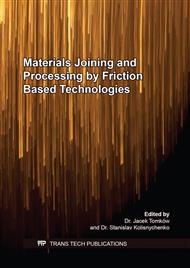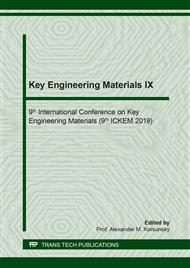[1]
R. S. Mishra, Z. Y. Ma, Friction stir welding and processing, Materials science and engineering: R: reports 50, 1-2 (2005) 1-78.
Google Scholar
[2]
K. P. Mehta, V. J. Badheka, A review on dissimilar friction stir welding of copper to aluminum: process, properties, and variants, Materials and Manufacturing Processes 31, 3 (2016) 233-254.
DOI: 10.1080/10426914.2015.1025971
Google Scholar
[3]
K. P. Mehta, A review on friction-based joining of dissimilar aluminum–steel joints. Journal of Materials Research 34, 1 (2019) 78-96.
DOI: 10.1557/jmr.2018.332
Google Scholar
[4]
M. Reimann, T. Gartner, U. Suhuddin, J. Göbel, J. F. dos Santos, Keyhole closure using friction spot welding in aluminum alloy 6061–T6, Journal of Materials Processing Technology, 237 (2016) 12-18.
DOI: 10.1016/j.jmatprotec.2016.05.013
Google Scholar
[5]
Y. X. Huang, Bing Han, H. J. Ying Tian, S. X. Liu, J. C. Lv, J. S. Feng, Leng, Y. Li, New technique of filling friction stir welding, Science and Technology of Welding and Joining 16, 6 (2011) 497-501.
DOI: 10.1179/1362171811y.0000000032
Google Scholar
[6]
B. Han, Y. Huang, S. Lv, L. Wan, J. Feng, G. Fu, AA7075 bit for repairing AA2219 keyhole by filling friction stir welding, Materials & Design, 51 (2013) 25-33.
DOI: 10.1016/j.matdes.2013.03.089
Google Scholar
[7]
G. F. Zhang, W. M. Jiao, J. X. Zhang, Filling friction stir weld keyhole using pin free tool and T shaped filler bit, Science and Technology of Welding and Joining, 19, 2 (2014) 98-104.
DOI: 10.1179/1362171813y.0000000161
Google Scholar
[8]
S. J. Prakash, S. Muthukumaran, Refilling probe hole of friction spot joints by friction forming, Materials and Manufacturing Processes 26, 12 (2011) 1539-1545.
DOI: 10.1080/10426914.2011.551959
Google Scholar
[9]
S. Venukumar, S. Muthukumaran, Y. Swaroop, Microstructure and Mechanical Properties of Refilled Friction Stir Spot Welding of Commercial Pure Aluminium. In Trans Tech Publications, Materials Science Forum 765 (2013) 776-780.
DOI: 10.4028/www.scientific.net/msf.765.776
Google Scholar
[10]
Z. Shen, X. Yang, Z. Zhang, L. Cui, T. Li, Microstructure and failure mechanisms of refill friction stir spot welded 7075-T6 aluminum alloy joints, Materials & design 44 (2013) 476-486.
DOI: 10.1016/j.matdes.2012.08.026
Google Scholar
[11]
M. D. Tier, T. S. Rosendo, J. F. Dos Santos, N. Huber, J. A. Mazzaferro, C. P. Mazzaferro, T. R. Strohaecker, The influence of refill FSSW parameters on the microstructure and shear strength of 5042 aluminium welds, Journal of materials processing technology 213, 6 (2013) 997-1005.
DOI: 10.1016/j.jmatprotec.2012.12.009
Google Scholar
[12]
L. M. Santana, U. F. H. Suhuddin, M. H. Ölscher, T. R. Strohaecker, J. F. dos Santos, Process optimization and microstructure analysis in refill friction stir spot welding of 3-mm-thick Al-Mg-Si aluminum alloy, The International Journal of Advanced Manufacturing Technology 92, 9-12 (2017) 4213-4220.
DOI: 10.1007/s00170-017-0432-9
Google Scholar
[13]
P. Li, X. Zhongfeng, Y. Chun, L. Hao, Y. Junshan, C. Guoyu, Mechanical properties and microstructure analysis of refilling friction stir welding on 2219 aluminum alloy, Acta Metallurgica Sinica (English Letters) 25, 3 (2012) 225-234.
Google Scholar
[14]
R. J. Ding, P. A. Oelgoetz, U.S. Patent No. 5,893,507. Washington, DC: U.S. Patent and Trademark Office (1999).
Google Scholar



